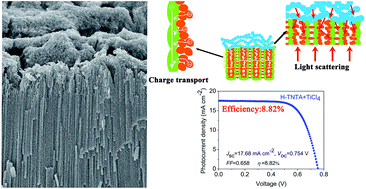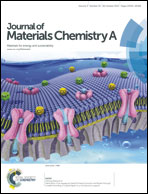Facile preparation of hierarchical TiO2 nanowire–nanoparticle/nanotube architecture for highly efficient dye-sensitized solar cells
Abstract
In the present work, we developed a facile post-treatment approach, namely one-step hot-water soaking, to the fabrication of double-layer and hierarchical TiO2 nanotube arrays (H-TNTAs) comprising a nanoparticle/nanotube hybrid layer and a TiO2 nanowire cap layer for highly efficient dye-sensitized solar cells (DSSCs). The nanoparticle/nanotube hybrid structure of the H-TNTA provides enormous specific surface area for sufficient dye attachment and the TiO2 nanowire cap layer serves as a light-scattering layer with increased dye-absorption for superior light harvesting efficiency. This engineered integration makes it possible to control the dye-anchoring, charge transport, charge collection, and light scattering within a photoanode simultaneously. The DSSC based on the well tailored architecture yields an exciting power conversion efficiency of 8.21% under 100 mW cm−2, corresponding to 51% improvement as compared with the cell built on the pristine TNTA (P-TNTA, 5.43%). The efficiency can be further improved to 8.82% when the H-TNTA photoanodes are subjected to an additional TiCl4 treatment.


 Please wait while we load your content...
Please wait while we load your content...